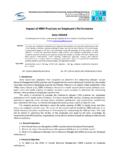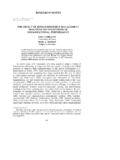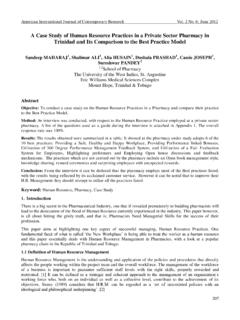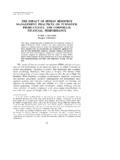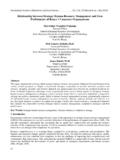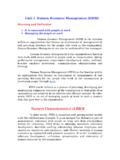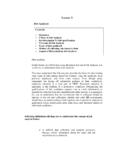Transcription of Human Resource Management and Productivity
1 NBER WORKING PAPER SERIESHUMAN Resource Management AND PRODUCTIVITYN icholas BloomJohn Van ReenenWorking Paper 16019 BUREAU OF ECONOMIC RESEARCH1050 Massachusetts AvenueCambridge, MA 02138 May 2010 This paper has been prepared for a chapter in the Handbook of Labor Economics Volume IV editedby David Card and Orley Ashenfelter. We would like to thank the Economic and Social ResearchCouncil for their financial support through the Center for Economic Performance. This survey drawssubstantially on joint work with Daron Acemoglu, Philippe Aghion, Eve Caroli, Luis Garicano, ChristosGenakos, Claire Lelarge, Ralf Martin, Raffaella Sadun and Fabrizio Zilibotti. We would like to thankOrley Ashenfelter, Oriana Bandiera, Alex Bryson, David Card, Edward Lazear, Paul Oyer, John Roberts,Kathy Shaw and participants in conferences in Berkeley and the LSE for helpful comments.
2 The viewsexpressed herein are those of the authors and do not necessarily reflect the views of the National Bureauof Economic Research. 2010 by Nicholas Bloom and John Van Reenen. All rights reserved. Short sections of text, not toexceed two paragraphs, may be quoted without explicit permission provided that full credit, including notice, is given to the Resource Management and ProductivityNicholas Bloom and John Van ReenenNBER Working Paper No. 16019 May 2010 JEL No. L2,M2,O32,O33 ABSTRACTIn this handbook of labor economics chapter we examine the relationship between Human ResourceManagement (HRM) and Productivity . HRM includes incentive pay (individual and group) as wellas many non-pay aspects of the employment relationship such as matching (hiring and firing) andwork organization ( teams, autonomy).
3 We place HRM more generally within the literature onmanagement practices and Productivity . We start with some facts on levels and trends of both HRMand Productivity and the main economic theories of HRM. We look at some of the determinants ofHRM risk, competition, ownership and regulation. The largest section analyses the impact of HRMon Productivity emphasizing issues of methodology, data and results (from micro-econometric studies).We conclude briefly with suggestions of avenues for future frontier BloomStanford UniversityDepartment of Economics579 Serra MallStanford, CA 94305-6072and Van ReenenDepartment of EconomicsLondon School of EconomicsCentre for Economic PerformanceHoughton StreetLondon WC2A 2 AEUnited Kindomand 1.
4 IntroductionTraditionally, labor economics focused on the labor market rather than looking inside the black box of firms. Industrial sociologists and psychologists made the running in Human Resource Management (HRM). This has changed dramatically in last two decades. Human Resource Management (HRM) is now a major field in labor economics. The hallmark of this work is to use standard economic tools applied to the special circumstances of managing employees within companies. HRM economics has a major effect on the world through teaching in business schools, and ultimately what gets practiced in many organizations. HRM covers a wide range of activities. The main area of study we will focus on will be incentives and work organization.
5 Incentives include remuneration systems ( individuals or group incentive/contingent pay) and also the system of appraisal, promotion and career advancement. By work organization we mean the distribution of decision rights (autonomy/decentralization) between managers and workers, job design ( flexibility of working, job rotation), team-working ( who works with whom) and information provision. Space limitations mean we do not cover matching (see Oyer and Schaffer, this Volume) or skill development/training. Second, we will only devote a small amount of space to employee representation such as labor unions (see Farber, this Volume).
6 Third, we should also mention that we focus on empirical work rather than theory (for recent surveys see Gibbons and Roberts, 2008, and in particular Lazear and Oyer, 2008) and micro-econometric work rather than macro or qualitative studies. Fourth, we focus on HRM over employees rather than CEOs, which is the subject of a vast literature (see Murphy, 1999, or Edmans, Gabaix and Landier, 2008, for surveys). Where we depart from several of the existing surveys in the field is to put HRM more broadly in the context of the economics of Management . To do this we also look in detail at the literature on Productivity dispersion. The structure of the chapter is as follows. In Section 2 we detail some facts about HRM and Productivity both in the cross sectional and time series dimension.
7 In Section 3 we look at the impact of HRM on Productivity with an emphasis on methodologies and the mechanisms. In Section 4 we 3 discuss some theoretical perspectives, contrasting the usual Design approach to our concept of HRM as one example of Management as a technology . In Section 5 we discuss some of the factors determining HRM, focusing on risk, competition, ownership, trade and regulation. Section 6 concludes. 2. Some facts on HRM and Productivity practices In the 1970s the general assumption was that incentive pay would continue to decline in importance. This opinion was based on the fact that traditional unskilled jobs with piece-rate incentives were declining, and white collar jobs with stable salaries and promotion based incentives were increasing.
8 Surprisingly, however, it appears (at least in the US) that over the last three decades a greater proportion of jobs have become rewarded with contingent pay, and this is in fact particularly true for salaried workers. There are two broad methods of assessing the importance of incentive pay: Direct and Indirect methods. Direct methods use data on the incidence of HRM, often drawn from specialist surveys. Indirect methods use various forms of statistical inference, ideally from matched worker-firm data, to assess the extent to which pay is contingent on performance. We deal mainly with the direct evidence and then discuss more briefly the indirect evidence. HRM measured using direct methods Incentive Pay Individual incentive pay information is available from a variety of sources.
9 Using the Panel Study of Income Dynamic (PSID) Lemieux, McCleod and Parent (2009) estimate that about 14% of US prime age men in 1998 received performance pay (see Figure ). They define a worker as receiving performance pay if any part of compensation includes bonus, commission or piece rate1 (data on stock options and shares is not included). They find a much higher incidence of performance pay jobs (37% on average between 1976-1998) defined as a job where a worker ever received some kind of 1 Overtime is removed, but the question is imperfect pre-1993 which could lead to undercounting performance pay. 4 performance pay2. They also look at the National Longitudinal Survey of Youth (NLSY) which shows coverage of performance pay jobs for men of 26% in 1988 to 1990.
10 Other papers deliver similar estimates of around 40% to 50% of US employees being covered by some form of performance pay. For example, using the US General Social Survey Kruse, Blasi and Park (2009) estimate that 47% of American workers were covered by some group incentive scheme in 2006. Of this 38% of employees were covered by profit sharing, 27% by gain-sharing, 18% by stock ownership (9% by stock options) and by all three types. Lawler et al (2003) surveyed Fortune 1,000 corporations between 1987 and 2002 asking detailed questions on their HRM3. Using midpoints of their results (which are in bands) Lemieux et al (2008) calculate that 44% of workers were covered by incentive pay in 2002.


